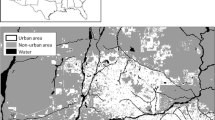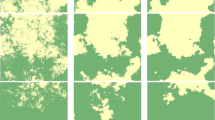Abstract
Human activities affect both the amount and configuration of habitat. These changes have important ecological implications that can be measured as changes in landscape connectivity. I investigated how urbanization interacts with the initial amount and aggregation of habitat to change dispersal potential, restoration potential, and the risk of spatially extensive disturbances. I used a factorial set of simulated landscapes and subjected each landscape to habitat loss by overlaying 66 different US urban areas. I used a common connectivity metric, CONNECT, to assess the magnitude and direction of changes for a range of dispersal distances. My results show that the relationship between habitat loss and connectivity loss is non-linear and subject to interactions between the spatial patterns of habitat distribution, urban morphology, and dispersal capabilities. The implications of a given urban form vary widely as a function of habitat distribution and dispersal capabilities. This implies that impact assessments, restoration activities, and conservation planning should consider historical habitat distribution when evaluating observed changes in connectivity. While my results clearly show that more aggregated or continuous habitats are more vulnerable to connectivity loss, this approach can also be used to identify landscapes where restoring connectivity will be particularly effective, for example through placement of stepping stone habitats.




Similar content being viewed by others

References
Alberti M, Marzluff JM, Shulenberger E, Bradley G, Ryan C, Zumbrunnen C (2003) Integrating humans into ecology: opportunities and challenges for studying urban ecosystems. Bioscience 53:1169–1179
Andrzejewski R, Babinska-Werka J, Gliwicz J, Goszczynski J (1978) Synurbization processes in population of Apodemus agrarius. I. Characteristics of populations in an urbanization gradient. Acta Theriol 23:341–358
Aurambout JP, Endress AG, Deal BM (2005) A spatial model to estimate habitat fragmentation and its consequences on long-term persistence of animal populations. Environ Monit Assess 109:199–225
Bender DJ, Tischendorf L, Fahrig L (2003) Using patch isolation metrics to predict animal movement in binary landscapes. Landsc Ecol 18:17–39
Bierwagen BG (2003) Ecological and microevolutionary effects of urban land-use change on butterflies. University of California, Santa Barbara
Bierwagen BG (2005) Predicting ecological connectivity in urbanizing landscapes. Environ Plann, B Plann Des 32:763–776
Crooks KR, Soulé ME (1999) Mesopredator release and avifaunal extinctions in a fragmented system. Nature 400:563–566
Cumming S, Vernier P (2002) Statistical models of landscape pattern metrics, with application to regional scale dynamic forest simulations. Landsc Ecol 17:433–444
D’Antonio C, Meyerson LA (2002) Exotic plant species as problems and solutions in ecological restoration: a synthesis. Restor Ecol 10:708–713
Ecke F, Christensen P, Sandstrom P, Hornfeldt B (2006) Identification of landscape elements related to local declines of a boreal grey-sided vole population. Landsc Ecol 21:485–497
Ellis EC, Wang HQ, Xiao HS, Peng K, Liu XP, Li SC, Ouyang H, Cheng X, Yang LZ (2006) Measuring long-term ecological changes in densely populated landscapes using current and historical high resolution imagery. Remote Sens Environ 100:457–473
ESRI (1999) ArcView GIS 3.2. Environmental Systems Research Institute, Inc., Redlands, California
ESRI (2002) ArcGIS. Environmental Systems Research Institute, Inc., Redlands, California
Fahrig L, Merriam G (1985) Habitat patch connectivity and population survival. Ecology 66:1762–1768
Fahrig L, Paloheimo J (1988) Effect of spatial arrangement of habitat patches on local population size. Ecology 69:468–475
Ferraz SFD, Vettorazzi CA, Theobald DM, Ballester MVR (2005) Landscape dynamics of amazonian deforestation between 1984 and 2002 in central Rondonia, Brazil: assessment and future scenarios. For Ecol Manag 204:67–83
Fromont E, Pontier D, Langlais M (2003) Disease propagation in connected host populations with density-dependent dynamics: the case of the feline leukemia virus. J Theor Biol 223:465–475
Gandon S, Rousset F (1999) Evolution of stepping-stone dispersal rates. Proc R Soc Lond, B 266:2507–2513
Gardner RH (1999) Rule: map generation and a spatial analysis program. In: Klopatek JM, Gardner RH (eds) Landscape ecological analysis: issues and applications. Springer, Berlin Heidelberg New York, pp 280–303
Gardner RH, O’Neill RV, Turner MG, Dale VH (1989) Quantifying scale-dependent effects of animal movement with simple percolation models. Landsc Ecol 3:217–227
Hargrove WW, Gardner RH, Turner MG, Romme WH, Despain DG (2000) Simulating fire patterns in heterogeneous landscapes. Ecol Model 135:243–263
Haynes KJ, Cronin JT (2006) Interpatch movement and edge effects: the role of behavioral responses to the landscape matrix. Oikos 113:43–54
Hess GR (1994) Conservation corridors and contagious disease: a cautionary note. Conserv Biol 8:256–262
Jacquemyn H, Honnay O, Galbusera P, Roldan-Ruiz I (2004) Genetic structure of the forest herb Primula elatior in a changing landscape. Mol Ecol 13:211–219
Jules ES, Shahani P (2003) A broader ecological context to habitat fragmentation: why matrix habitat is more important than we thought. J Veg Sci 14:459–464
Keitt TH, Urban DL, Milne BT (1997) Detecting critical scales in fragmented landscapes. Conserv Ecol (online) 1, 4
King AW, With KA (2002) Dispersal success on spatially structured landscapes: when do spatial pattern and dispersal behavior really matter? Ecol Model 147:23–39
Li X, He HS, Wang X, Bu R, Hu Y, Chang Y (2004) Evaluating the effectiveness of neutral landscape models to represent a real landscape. Landsc Urban Plan 69:137–148
MacArthur RH, Wilson EO (1967) The theory of island biogeography. Princeton University Press, Princeton, New Jersey.
McCallum H, Dobson A (2002) Disease, habitat fragmentation and conservation. Proc R Soc Lond, B 269:2041–2049
McGarigal K, Cushman SA, Neel MC, Ene E (2002) Fragstats: spatial pattern analysis program for categorical maps. University of Massachusetts, Amherst, Massachusetts
McIntyre NE, Wiens JA (1999) Interactions between landscape structure and animal behavior: the roles of heterogeneously distributed resources and food deprivation on movement patterns. Landsc Ecol 14:437–447
McKinney ML (2006) Correlated non-native species richness of birds, mammals, herptiles and plants: scale effects of area, human population and native plants. Biological Invasions 8:415–425
Merriam G (1984) Connectivity: a fundamental characteristic of landscape pattern, vol. 1. In: Brandt J, Agger P (eds) Roskilde Universitetsforlag GeoRuc, Roskilde, Denmark, pp 5–15
Moilanen A, Hanski I (2001) On the use of connectivity measures in spatial ecology. Oikos 95:147–151
Moilanen A, Nieminen M (2002) Simple connectivity measures in spatial ecology. Ecology 83:1131–1145
O’Neill RV, Gardner RH, Turner MG, Romme WH (1992) Epidemiology theory and disturbance spread on landscapes. Landsc Ecol 7:19–26
Parendes LA, Jones JA (2000) Role of light availability and dispersal in exotic plant invasion along roads and streams in the h. J. Andrews experimental forest, Oregon. Conserv Biol 14:64–75
Pauchard A, Aguayo M, Pena E, Urrutia R (2006) Multiple effects of urbanization on the biodiversity of developing countries: the case of a fast-growing metropolitan area (Concepcion, Chile). Biol Conserv 127:272–281
Pfister JL (2004) Using landscape metrics to create an index of forest fragmentation for the state of Maryland. Towson University, pp 37
Pither J, Taylor PD (1998) An experimental assessment of landscape connectivity. Oikos 83:166–174
Richards WH, Wallin DO, Schumaker NH (2002) An analysis of late-seral forest connectivity in western Oregon, U.S.A. Conserv Biol 16:1409–1421
Ricketts TH (2001) The matrix matters: effective isolation in fragmented landscapes. Am Nat 158:87–120
Schultz CB (1998) Dispersal behavior and its implications for reserve design in a rare oregon butterfly. Conserv Biol 12:284–292
Simberloff D, Cox J (1987) Consequences and costs of conservation corridors. Conserv Biol 1:63–71
Söndgerath D, Schröder B (2002) Population dynamics and habitat connectivity affecting the spatial spread of populations—a simulation study. Landsc Ecol 1–14
Taylor PD, Fahrig L, Henein K, Merriam G (1993) Connectivity is a vital element of landscape structure. Oikos 68:571–573
Taylor J, Paine C, Fitzgibbon J (1995) From greenbelt to greenways—4 Canadian case-studies. Landsc Urban Plan 33:47–64
Templeton AR, Robertson RJ, Brisson J, Strasburg J (2001) Disrupting evolutionary processes: the effect of habitat fragmentation on collared lizards in the Missouri Ozarks. Proc Natl Acad Sci 98:5426–5432
Tischendorf L (2001) Can landscape indices predict ecological processes consistently? Landsc Ecol 16:235–254
Trenham PC, Koenig WD, Shaffer HB (2001) Spatially autocorrelated demography and interpond dispersal in the salamander Ambystoma californiense. Ecology 82:3519–3530
United Nations (2002) World urbanization prospects: the 2001 revision, data tables and highlights. Population Division of the Department of Economic and Social Affairs, New York
Vogelmann JE, Howard SM, Yang L, Larson CR, Wylie BK, Van Driel JN (2001) Completion of the 1990’s national land cover data set for the conterminous united states. Photogramm Eng Remote Sensing 67:650–662
Vos CC, Verboom J, Opdam PFM, Braak CJFT (2001) Toward ecologically scaled landscape indices. Am Nat 183:24–41
Weber TP, Houston AI, Ens BJ (1999) Consequences of habitat loss at migratory stopover sites: a theoretical investigation. J Avian Biol 30:416–426
Wiens JA, Schooley RL, Weeks RD (1997) Patchy landscapes and animal movements: do beetles percolate? Oikos 78:257–264
With KA, Gardner RH, Turner MG (1997) Landscape connectivity and population distributions in heterogeneous environments. Oikos 78:151–169
With KA, Cadaret SJ, Davis C (1999) Movement responses to patch structure in experimental fractal landscapes. Ecology 80:1340–1353
Wyser N (2003) A qualitative and quantitative structural landscape analysis: case study in Monteverde, Costa Rica. Swiss Federal Institute of Technology, Lausanne, pp 60
Acknowledgements
I would like to thank C. Pyke and B. Langford for technical assistance. C. Pyke, B. Kendall, S. Andelman, K. Clarke, F. Davis, and several anonymous reviewers provided valuable comments on earlier versions of this manuscript. Modeling and landscape analysis were performed at the National Center for Ecological Analysis and Synthesis (NCEAS) and the Applied Population Ecology Lab at the University of California, Santa Barbara. Funding for this work was provided in part by a NSF Doctoral Dissertation Improvement Grant.
Author information
Authors and Affiliations
Corresponding author
Rights and permissions
About this article
Cite this article
Bierwagen, B.G. Connectivity in urbanizing landscapes: The importance of habitat configuration, urban area size, and dispersal. Urban Ecosyst 10, 29–42 (2007). https://doi.org/10.1007/s11252-006-0011-6
Received:
Accepted:
Published:
Issue Date:
DOI: https://doi.org/10.1007/s11252-006-0011-6



